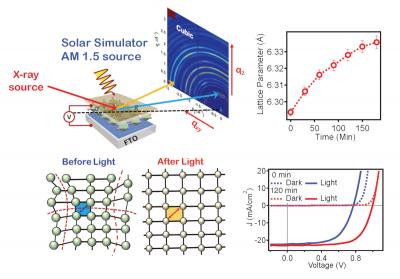A collaborative research team from Los Alamos National Laboratory, Rice University, Purdue University, Northwestern University, Institut FOTON CNRS UMR 6082 (France) and Argonne National Laboratory has created a number of hybrid perovskite solar cells with a FA0.7MA0.25Cs0.05PBI3 composition and measured them using a variety of techniques including grazing-incidence wide-angle x-ray scattering (GIWAXS) maps at the X-ray Science Division 8-ID-E x-ray beamline of the APS (an Office of Science user facility at Argonne).
 The experimental setup (top left) and the corresponding light-induced lattice expansion effect, which leads to curing defects and relieving of lattice strain (bottom left) and as a result an increase in the open circuit voltage of a solar cell
The experimental setup (top left) and the corresponding light-induced lattice expansion effect, which leads to curing defects and relieving of lattice strain (bottom left) and as a result an increase in the open circuit voltage of a solar cell
In most of the cells, the researchers noted a substantial improvement in PCE from 18.5% to 20.5% under continuous light soaking with a 1-sun (100 mW/cm2) source as the lattice structure of the hybrid cells uniformly expanded. This expansion relieved local strains in the bulk material and better aligned the crystal planes, as evidenced by narrowing and uniform shifting of the Bragg peaks toward lower scattering values as seen by GIWAXS. The researchers explain that constant illumination generates electron-hole pairs in the perovskite material, decreasing the distortions of some bonds while elongating others, resulting in a generalized lattice expansion and relaxation. A similar phenomenon was seen with pure MAPbI3 thin films, suggesting that such lattice expansion under light is common for hybrid perovskite materials.
Previous experiments with MAPbI3 films demonstrated some changes in contact interfaces following light soaking, which were attributed to ion migration from the perovskite material to the contact. To rule out such effects in the current work, the experimenters performed x-ray photoelectron spectroscopy (XPS) before and after illumination, and also monitored open circuit voltage and fill factor values in darkness while applying a constant bias current. Neither technique showed any evidence of ion migration as seen in the MAPbI3 film experiments.
The lattice expansion persists for at least 30 minutes in the perovskite materials even when the films are rested in complete darkness after illumination. To exclude any possibility that the lattice expansion might be heat-induced, the experimenters maintained the perovskite films at constant temperature during illumination and in darkness. When exposed to greater illuminations of 10-sun intensity, the films maintained their PV efficiency for considerable time, degrading only to 80% after 600 minutes. The investigators also noted that the light-induced lattice expansion had no noticeable effects on the photovoltaic stability of their devices, even after more than 1500 hours of continuous operation under 1-sun illumination.
These findings were said to not only represent a highly significant step forward in the search for stable and practical perovskite-based photovoltaic devices, but also point the way toward new research possibilities in the fundamental understanding of perovskite-based materials and their behaviors.

